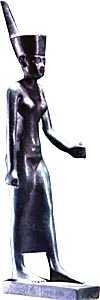Neith
|
|
<hiero>n:t R25 B1</hiero>
In Egyptian mythology, Neith (also known as Nit, Net and Neit) was the patron deity of Sais, in the Western Delta. Originally, Neith was a goddess of the hunt and of war, and had as her symbol, like the town of Sais itself, two crossed Arrows over a shield. It is thought that Neith may correspond to the Berber and Punic goddess Tanit (Ta-Nit). In her early form, as a goddess of war, she was said to make warriors' weapons, and guard their bodies when they died.
However, her symbol also bore resemblance to a loom, and so it was that Neith additionally became goddess of weaving, and gained her name, which means weaver. As a goddess of weaving and the domestic arts, she was a protectress of women and a guardian of marriage, and so Royal woman often named themselves after Neith in her honour. As she was also goddess of war, and thus had an additional association with death, it was said that she wove the the bandages and shrouds worn by the mummified dead as a gift to them, and thus she became viewed as a protector of one of the Four sons of Horus, specifically of Duamutef, the deification of the canopic jar storing the stomach, since the stomach was the part of the body that was mostly attacked in battle. It was said that she shot arrows at any evil spirits that attacked the jar.
In time, her name, which could also be interpreted as meaning water, lead to her being considered as the personification of the primordial waters of creation, in the Ogdoad mythology, and thus the mother of Ra. Since she had become a water goddess, she was also viewed as the mother of Sobek, the crocodile. It was this association with water, i.e. the Nile, that lead to her sometimes being considered the wife of Chnum. As the goddess of creation, it sometimes occurred that people took her other position, as goddess of weaving, and said that she wove the world on her loom. Plutarch says her temple (of which nothing now remains) bore the inscription: I am All That Has Been, That Is, and That Will Be. No mortal has yet been able to lift the veil that covers Me.
In much later times, her association with war, and death, lead to her being identified with Nephthys (and Anouke), from the Ennead, and thus considered a wife of Set. Despite this, it was said that she interceded in the war between Horus and Set, over the Egyptian throne, recommending that Horus rule.
In art, Neith appears as a woman with a weavers shuttle atop her head, holding a bow and arrows, a woman with the head of a lioness, as a snake, or as a cow. Sometimes Neith was pictured as a woman nursing a baby crocodile, and she was titled Nurse of Crocodiles. As the personification of the primordial waters, which, in the Ogdoad theology, had no gender, she was also thought of as being androgynous. As mother of Ra, she was sometimes described as the Great Cow who gave birth to Ra.
A great festival, called the Feast of Lamps, was held annually in her honor, and according to Herodotus her devotees burned a multitude of lights in the open air all night during the celebration. There is also evidence of an Osiris-like cult of a woman dying and being brought back to life that was connected with Neith. Plato's Timaeus stated that she was the Greek goddess 'Athene' by another name, although historically they do not share the same origins.
Alternative definitions
The planet Venus was once thought to have a moon, which was called Neith.
External links
- Nit (Neith), Goddess of Weaving, War, Hunding and the Red Crown, Creator Deity, Mother of Ra (http://www.touregypt.net/featurestories/nit.htm)
- Discussion of the supposed moon of Venus (http://www.solarviews.com/eng/hypothet.htm#neith)ar:نيث
bg:Нейт ca:Neith da:Neith de:Neith fr:Neith la:Neith fi:Neith sv:Neith

